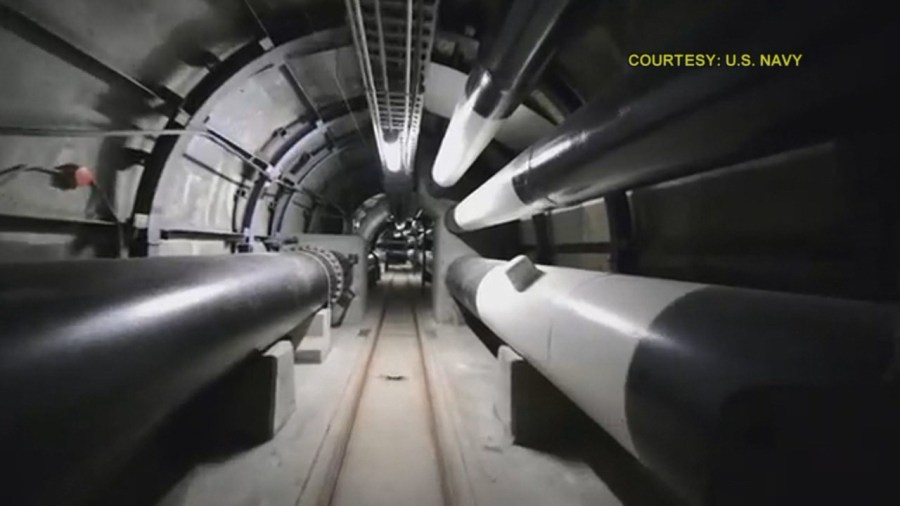HONOLULU (KHON2) — In recent months, the Navy has taken significant steps to address and rectify the long-standing environmental concerns surrounding the Red Hill Bulk Fuel Storage Facility (RHBFSF) on Oʻahu.
The facility has been the center of controversy due to the potential contamination of the island’s water supply, raising fears among local communities about the safety of their drinking water and the future of Oʻahu’s precious aquifer.
The Navy’s efforts, though extensive, have been closely monitored by state regulators, environmental agencies, and the public, all of whom demand transparency and accountability.
The Navy Closure Task Force-Red Hill (NCTF-RH), led by Rear Adm. Steve Barnett, has been at the forefront of these remediation efforts.
According to Barnett, the task force’s mission has been to assess and clean up the environment around Red Hill while also decommissioning the underground fuel storage tanks.
The task force’s work has involved collaboration with the Environmental Protection Agency (EPA) and the Hawaiʻi Department of Health (DOH) to ensure all regulatory requirements are met.
Barnett emphasized that the Navy remains committed to protecting Oʻahu’s aquifer and working closely with stakeholders to understand the island’s groundwater conditions.
One of the Navy’s primary focuses has been the Red Hill Site Assessment of Fuel Contamination.
This summer, the Navy developed an environmental site assessment plan, which serves as the foundation for all future remediation activities at Red Hill. This plan was submitted to regulators for review and comments, marking a significant step forward in addressing the contamination concerns.
Another critical area of focus has been the investigation of perfluoroalkyl and polyfluoroalkyl substances, commonly known as PFAS.
These chemicals, often referred to as “forever chemicals” due to their persistence in the environment, have been a growing concern for both regulators and the public. In response to these concerns, the Navy agreed to expedite the schedule and expand its sampling efforts.
A work plan was submitted to the Hawaiʻi DOH in June 2024, with a commitment to begin sampling at a series of monitoring wells around Red Hill in September 2024.
The Navy has also made significant progress in monitoring groundwater around Red Hill. Since 2021, the NCTF-RH has installed 21 new groundwater monitoring wells, with plans to complete a 22nd well by the end of August.
These wells are part of a comprehensive network designed to provide a better understanding of groundwater conditions in and around the facility. The Navy conducts bi-weekly sampling of these wells in accordance with a plan approved by the EPA and DOH.
In addition to these monitoring efforts, the Navy has been working on a Groundwater Flow Model, which was submitted in draft form to the DOH, EPA, and University of Hawaiʻi researchers in July 2024.
This model includes a contaminant fate and transport component, which is essential for understanding how contaminants move and interact with the environment over time. The final version of the model is expected to be submitted in September 2024.
The Navy’s response to potential spills has also been tested. On July 22, NCTF-RH staff completed a joint spill drill exercise that involved multiple agencies, including the EPA and Hawaiʻi Emergency Management Agency.
The exercise simulated a release of a mixture of water and cleaning solution during pressure washing operations, testing the Navy’s emergency response capabilities. Rear Adm. Marc Williams, NCTF-RH deputy commander, praised the team’s efforts, noting that the drill was crucial for ensuring the safe and efficient cleaning of tanks 7 and 8.
Despite these efforts, challenges remain. On August 15, a backup in the fuel-oil recovery line caused 25 gallons of a water-sludge mixture to enter a primary containment area at the facility.
Fortunately, there was no release to the environment, and the mixture was safely contained and disposed of. The EPA and DOH validated the Navy’s response the following day, confirming that the system operated as designed.
Cleaning efforts for tanks 7 and 8 have progressed, but not without setbacks. After sludge removal operations concluded in early July, inspections revealed the need for structural repairs before pressure washing equipment could be installed.
These repairs are currently underway. Air quality monitoring at the facility continues, with volatile organic compound levels remaining well below regulatory limits.
Preparatory work has also begun on tanks 5 and 6, with the installation of a forced air ventilation system. The initial venting phase is expected to begin within the next month, following required notifications to regulators and the public.
Throughout these efforts, NCTF-RH has maintained ongoing communication with the community and stakeholders. In July, task force leaders met with congressional staff, the Red Hill Remediation Roundtable, and various community groups, including the Waianae Moku Kupuna Council.
They also provided updates to Honolulu Mayor Rick Blangiardi and the Governor’s Water Committee on the progress being made at Red Hill.
To further engage with the public, NCTF-RH will host an Open House at the Moanalua Terrace Community Center on August 21.
The event will feature information booths, displays about the tank cleaning process, and a demonstration of an online dashboard showing the progress of the closure efforts.
Community members will have the opportunity to ask questions, view samples of sludge removed from the tanks, and learn more about the history of the Red Hill facility.
As the Navy continues its work at Red Hill, the eyes of Oʻahu’s residents remain fixed on the outcome. The stakes are high, with the future of the island’s water supply hanging in the balance.
You can click here for more information.
The task force’s actions in the coming months will be crucial in determining whether trust can be rebuilt and whether the environment can be restored.
